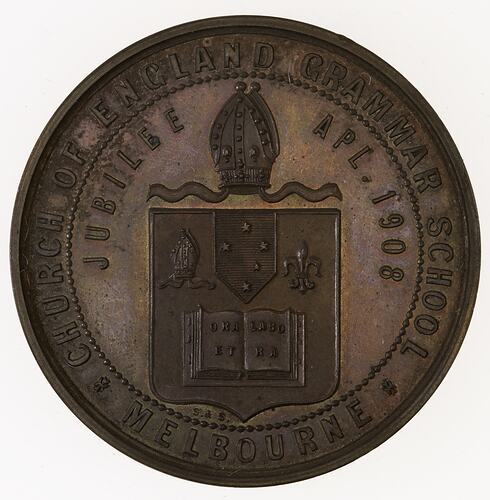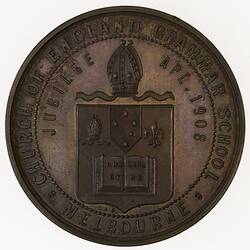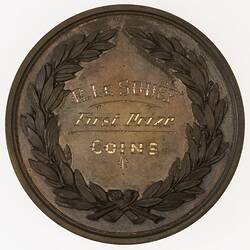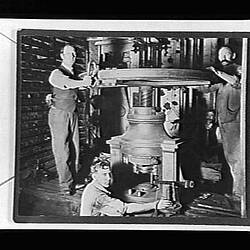Summary
Australia
Church of England Grammar School, Melbourne (AD)
Mint: Stokes & Sons
Awarded to: Le Souef, R.
Other Details: This Melbourne Church of England Grammar School first prize medal was awarded to Ronald Farquharson Le Soeuf for his display of coins at its Jubilee Exhibition in 1908. Melbourne Grammar School was founded on a 15-acre land grant in St Kilda Road in 1858, and celebrated its fiftieth jubilee in the year this medal was issued. The Jubilee Exhibition was somewhat of an afterthought, organised in a short time before the Christmas school holidays. Boys were asked to 'let the public see how they eomplyed their leisure hours', and the response was prompt and enthusiastic. The Exhibition 'showed unquestinably that our modern system of education, in spite of all that has been said about the examination evil and cramming, gives opportunity to the individual boy to find his natural bent and follow it.' Thousands attended the exhibition on its single day in 1908, the same day as the Jubilee Sports carnival. The exhibits were arranged into 11 sections in four rooms. Two rooms contained the coins, curios, natural collections, stamps, crests and autographs in glass cases. Tropies from Old Melburnians were displayed in a case. A table running the whole length of one room displayed post-card albums. Another glass case included a rifle captured in the Boer War. The walls groaned with watercolours, photographs, boat oars and a rudder. Le Souef's coins were one of the few displays that was awarded a medal. Le Souef went on to train as a doctor and served in World War I.
Physical Description
A bronze prize medal (48 mm diameter) of the Jubilee year featuring the School shield. Won by R. LeSouef for 'Coins'
Obverse Description
At centre, School shield surmounted by Bishop's mitre; around, JUBILEE APL. 1908; around on wide border defined by beads, CHURCH OF ENGLAND GRAMMAR SCHOOL * MELBOURNE *
Reverse Description
Engraved within a laurel wreath, R. LE SOUEF / First Prize / COINS
Edge Description
Plain
Significance
The Jubilee Exhibition was somewhat of an afterthought, organised in a short time before the Christmas school holidays. Boys were asked to 'let the public see how they eomplyed their leisure hours', and the response was prompt and enthusiastic. The Exhibition 'showed unquestinably that our modern system of education, in spite of all that has been said about the examination evil and cramming, gives opportunity to the individual boy to find his natural bent and follow it.' Thousands attended the exhibition on its single day in 1908, the same day as the Jubilee Sports carnival. The exhibits were arranged into 11 sections in four rooms. Two rooms contained the coins, curios, natural collections, stamps, crests and autographs in glass cases. Tropies of Old Melburnians were displayed in a case. A table running the whole length of one room displayed post-card albums. Another glass case included a rifle captured in the Boer War. The walls groaned with watercolours, photographs, boat oars and a rudder. Le Souef's coins were one of the few displays that was awarded a medal. -The Melburnian, 1908. -D. Tout-Smith 2/2/2004.
More Information
-
Collecting Areas
Medicine & Health, Public Life & Institutions, Numismatics & Philately
-
Acquisition Information
Transfer from National Gallery of Victoria (NGV), 15 Mar 1976
-
Date Issued
1908 AD
-
Issued By
-
Mint
Stokes & Sons, Melbourne, Greater Melbourne, Victoria, Australia, 1908
-
Commissioned By
Melbourne Church of England Grammar School, Melbourne, Greater Melbourne, Victoria, Australia, 1908
-
Awarded To
Ronald F. Le Souëf, Melbourne, Greater Melbourne, Victoria, Australia, 1908
-
Inscriptions
Obverse: CHURCH OF ENGLAND GRAMMAR SCHOOL * MELBOURNE * JUBILEE APL. 1908 ORA ET LABORA Reverse: R. LE SOUEF First Prize COINS
-
Series
-
Material
Copper
-
Axis
12
-
Classification
-
Category
-
Discipline
-
Type of item
-
Dimensions
51 mm (Outside Diameter), 59.29 g (Weight)
-
Shape
Round
-
Keywords




